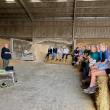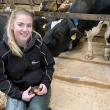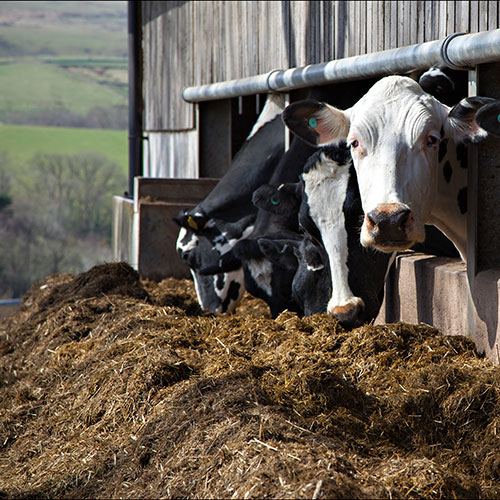Advanced Robot were the first company with a dedicated robotic division and were able to pull data out of the robots regularly to make improvements on farm.
Rumen Development key to future productivity
Interrogating performance data and identifying calf-rearing pinch points is key to improving heifer growth rates and first lactation performance. First reported in Cow Management.

Focusing on rumen development in both the pre- and post-weaning phase is key to improving heifer growth rates. And one Ayrshire-based dairy business has also improved animal health, fertility and production by taking this approach.
The Veitch family runs the 210-cow pedigree Holstein herd, plus 192 followers, at Strandhead Farm, in South Ayrshire. Cows are milked through four Lely robots and herd average yield is 14,500kg of milk, at 3.83% butterfat and 3.3% protein. This impressive output is a reflection of the team’s ability to understand what it takes to manage a herd of healthy and productive cows.
Ten years ago the family invested in a purpose-built robot shed, where cows have free access to milking, large comfortable cubicles, and a low-stress environment. While the cows were producing more than 40 litres of milk per day, this placed significant pressure on the youngstock team to ensure replacements reached the optimal weight, height, and body condition, crucial to heifers achieving between 82% and 85% of mature-cow yields when entering the milking herd.
The Veitch family’s passion for dairy breeding means that genetics also plays a significant role in the herd’s high milk production. “We knew the heifers had the potential to achieve the correct weight and age at first calving, but they were falling short of our targets which are 23 months for age of first calving (AFC) and 630kg weight at calving in,” explains Mr Gary France, who manages the herd.
Data Analysis
So he asked Advanced Ruminant Nutrition’s heifer rearing manager Liz Newman for help to boost youngstock growth rates.

Table 1: Improvements following a focus on rumen development at Strandhead Farm
She carried out a comprehensive analysis of calf-rearing data, the calves, and their environment to identify key bottlenecks in the system. “Collecting data on growth rates, fertility, disease, drug use, etc. is just the first step,” explains Liz. “It's essential to then interpret the information within the context of the individual farm. That means looking at the entire system and recognising that no two dairy units are the same. From there, we can pinpoint and prioritise the specific challenges that may be limiting youngstock performance.”
She also emphasises the importance of ongoing measurement and monitoring to ensure continued success and long-term sustainability of any changes that are put in place. “Every unit and herd will face different internal and external pressures, so it’s essential to adapt and respond accordingly to maintain effective youngstock management.”
With that in mind, the team began by implementing robust measuring and monitoring protocols. “We introduced regular weighing and body condition scoring for our heifers throughout the entire system,” explains Gary. “This gave us clear insight into where improvements were needed. Liz also helped us establish protocols that complemented her nutritional guidance, ensuring a more targeted and effective approach.”
Data revealed that calves were not achieving target daily liveweight gains after weaning, with between 70 and 180 days old highlighted as a pinch point. “We could also see the heifers were failing to the right height or structure to hit KPI targets,” says Liz. “And heifers were also falling short of target milk yields when entering the milking herd. The main issue was that both the pre- and post-weaning diets needed to be adjusted to promote rumen development.
“One of the most critical factors affecting calf health, and the key to successful weaning, is ensuring healthy rumen development. If we don’t get it right from the start, this impacts future milk production because the rumen is also central to feed efficiency and productive performance,” she adds.
“It’s also important to note that whatever the weaning age, the calf environment or choice of milk powder, producers will fail to support the daily liveweight gains needed to grow heifers to the point of breeding if the rumen is under developed.”
Poor rumen development in the milk feeding phase of rearing means that once calves are weaned they are less able digest and utilise feed, causing a reduction in health and growth rates and increasing heifer age at first calving, which has a financial impact.
Introducing water and a high-quality starter feed early in a calf’s life plays a critical role in initiating rumen development, driving both structural and metabolic development of the ruminal epithelium.
“Once a calf starts consuming starter feed, it typically takes between two and three weeks for the microbial population in the rumen to grow sufficiently to digest grain effectively,” explains Liz. “During this period, energy from solid feed begins to contribute meaningfully to growth. Supporting this transition with appropriate nutrition and management significantly improves the likelihood of a ‘smooth’ weaning process, without compromising health or performance.”
To improve rumen development at Strandhead Farm, the team switched the calf starter feed to a proven product, developed with the aim of encouraging higher intakes, promoting structural development and driving rumen maturation. Water was made readily available in individual pens.
The team followed a clear weaning plan, refined to reduce stress, ensuring that calves transitioned smoothly onto solid feeds. Post-weaning was a key area for the team to improve. Calf diet from weaning to six months was carefully managed. All forage was removed apart from straw and concentrates that are specifically designed to maintain growth while promoting rumen development. These combined changes created a more structured and supportive environment for young calves, setting them up for healthier, more productive futures.
Prioritising rumen development, enabled the team to achieve the target weight of 630Kg calving in with a tight range improving DLWG on milk from an average of 0.84kg/day to 1.05kg/day, and heifers from 70-180 days from 0.56kg/day to 0.96kg/day. Table 1. Further demonstrates that, in addition to this, the team were able to reduce the average age at first calving, increase heifer milk yields and improve longevity.
“The key to success was improving rumen development,” says Liz. “However, if I had one key takeaway it would be to measure and monitor, interrogate the data and use the experience from your own herd to make continual improvements on your farm.”
〈 BACK




